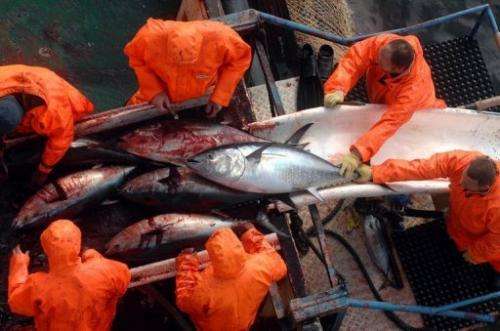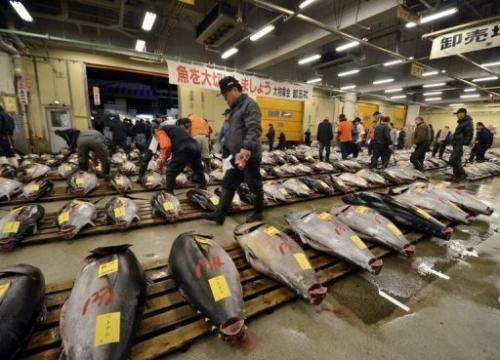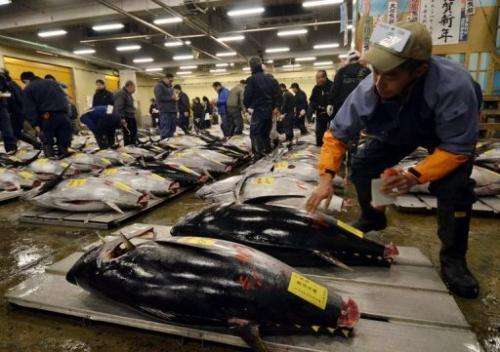Fishermen load tuna caught at a bluefin tuna farm around the mid Adriatic Croatian town of Zadar. Fishing nations meet in Morocco this week to thrash out tuna quotas as experts urge maintaining bluefin catch limits amid signs of the species making a comeback.
Fishing nations meet in Morocco this week to thrash out tuna quotas as experts urge maintaining bluefin catch limits amid promising signs of the decimated species making a comeback.
Hunted to the brink of extinction to feed a burgeoning sushi market, the Atlantic bluefin tuna was placed on the endangered list of the International Union for the Conservation of Nature (IUCN).
Stocks are estimated to have halved over four decades in some areas, with catches in the 1990s exceeding 60,000 tons per year.
Jolted into action by evidence of the game fish's looming annihilation, the International Commission for the Conservation of Atlantic Tunas (ICCAT) agreed to a 32,000-ton annual catch limit in 2006.
Two years later, environmentalists fought a losing battle for the introduction of a complete ban on bluefin fishing, but the ICCAT introduced progressively tougher limits year after year.
The current annual quota is 12,900 tons for the Mediterranean and east Atlantic and 1,750 tons for the west Atlantic—a figure scientists say should allow a complete population recovery by about 2020.
Last month, ICCAT scientists said they had found the first evidence that the fishing limits were spawning a bluefin revival in the east Atlantic and Mediterranean.
For a week from Monday, the ICCAT's 48 member countries will meet in Agadir on Morocco's west coast to consider whether to alter the Total Allowable Catch (TAC), an annual upper limit, for the next three years.
Fishmongers look at large bluefin tuna at Tokyo's Tsukiji fish market. For a week from Monday, the ICCAT's 48 member countries will meet in Morocco to consider whether to alter the Total Allowable Catch, an annual upper limit, for the next three years.
"We are still very concerned about control and the incidence of illegal fishing of this stock," Sergi Tudela, head of fisheries at green group WWF Mediterranean, warned ahead of the meeting.
"The WWF is encouraging ICCAT contracting parties not to relax their recovery ambitions for this year... and keep the TAC at 12,900 tons," he said in a teleconference.
With sections of the fishing industry pushing for a relaxation of quotas, the Pew Environment Group also urged a cautionary approach.
"If the data is correct, we have seen a quicker turnaround than expected," said Pew expert Remi Parmentier.
"But the authors of the (ICCAT) report have pointed out so many uncertainties that this is not the time to lower our guard."
In September, experts at an IUCN conference warned that global tuna stocks were fast reaching the limits of fishing sustainability.
A fishmonger checks large bluefin tuna at Tokyo's Tsukiji fish market. Hunted to the brink of extinction to feed a sushi market, the Atlantic bluefin tuna was placed on the endangered list of the International Union for the Conservation of Nature.
Five of the world's eight tuna species are classified as threatened or near-threatened, they said.
The Atlantic bluefin species, which can live to 40 years and grow to more than four metres (13 feet) long, is in the gravest danger of disappearing.
It is so highly prized by sushi-loving Japanese that a 269-kilogram (592-pound) fish went for a record 56.49 million yen ($737,000 at the time) in January auctions.
The Atlantic bluefin spawn just once a year and do not reach reproductive maturity until they are eight to 12 years old, making them more vulnerable to overfishing than smaller species which spawn more frequently.
The global tuna industry is an economic juggernaut with fishing in the Pacific Ocean alone—accounting for 65 percent of the global commercial catch—worth around $5.5 billion annually.
The ICCAT is tasked with the conservation of 30 fish species. Its members include the United States, Canada, Russia, Britain, China, several Mediterranean countries, the European Union and Japan, which single-handedly consumes over 75 percent of all the bluefin tuna caught, according to the WWF.
(c) 2012 AFP

























